Category: Amazon RDS
Cloud Innovation at Intuit and Edmodo using Amazon RDS
Recently our CTO Werner Vogels had a great conversation with Troy Otillio from Intuit and Jack Murgia from Edmodo. These innovators are using Amazon RDS to free up their time to focus on whats important to them building value for their customers.
Here are some of my favorite bits:
Troy: Moving to AWS has enabled us with operational agility to deliver more value to those customers without having to worry about scale and infrastructure maintenance. We now have more time to focus on innovation while being confident that when demand increases we can easily add more capacity.
Jack: Anything that saves time and simplifies processes for employees of a young startup has a positive affect that CAN NOT be overstated. The peace of mind part needs no explanation. Nobody on our team regrets moving to RDS MySQL – quite the opposite; we all agree we don’t want to think about where we would have been without RDS.
Troy: We love RDS it’s reduced our operational workload by a noticeable factor but even more exciting is the benefits around fast recovery enabled by the Multi-Availability Zone capability. My team often brags about the one-click creation of read replicas, ability to upsize or downsize the database without downtime and automatic back-up.
Read the full interview to learn more!
By the way, as I have noted before, if you want to try Amazon RDS, you can do that for free. Head on over to the free trial page. Tell us about the cool new app you build on RDS!
— Jeff;
Relational Database Service – Increased Snapshot Retention Period
The automated backup feature allows our customers to back up and restore their Relational Database Service (RDS) DB Instances. You can simply choose a non-zero backup retention period from the AWS Management Console:
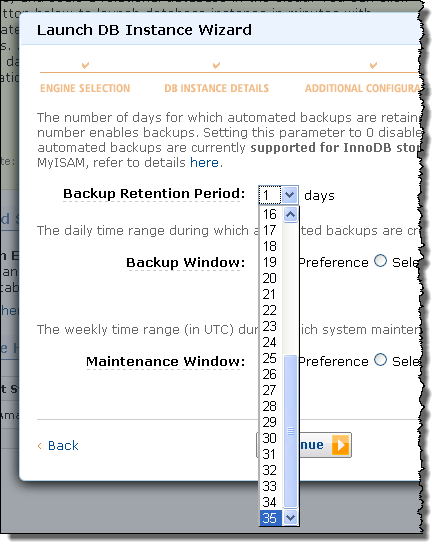
After fielding a number of customer requests, we have increased the maximum retention period from 8 days to 35 days. A number of our customers have asked for this new limit in order to retain at least one month’s worth of backups for compliance purposes.
Based on feedback from customers, RDS recently made the automated backups of your DB Instances available for copy or restore. The snapshots are visible within the Console. You can create a new DB Instance from any of your snapshots by simply right-clicking and choosing the Restore From DB Snapshot command:
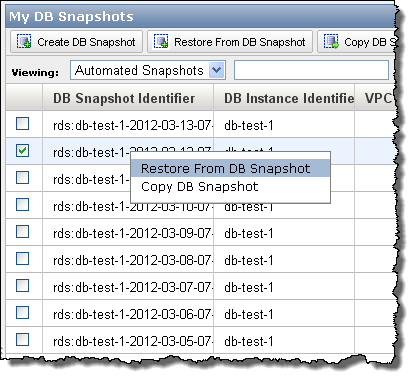
If you need to retain a particular automated backup snapshot for more than 35 days, you can copy it:
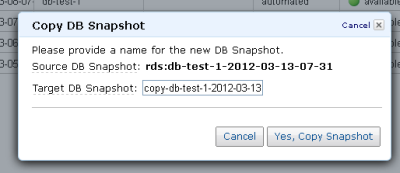
The copy will be stored as a Manual Snapshot and you can keep it around for as long as you’d like:
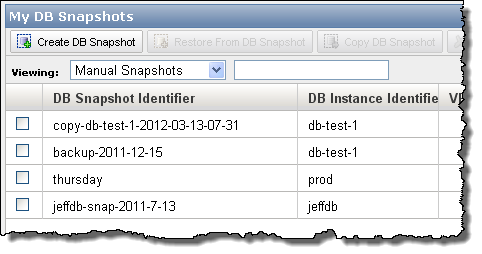
In other RDS news, we recently added support for MySQL 5.1.61 and MySQL 5.5.20.
We’re always happy to respond to requests and suggestions from our customers. If you have a request for the RDS team, please feel free to leave a message in the Amazon RDS Forum.
— Jeff;
Dropping Prices Again– EC2, RDS, EMR and ElastiCache
AWS works hard to lower our costs so that we can pass those savings back to our customers. We look to reduce hardware costs, improve operational efficiencies, lower power consumption and innovate in many other areas of our business so we can be more efficient. The history of AWS bears this out — in the past six years, weve lowered pricing 18 times, and today were doing it again. Were lowering pricing for the 19th time with a significant price decrease for Amazon EC2, Amazon RDS, Amazon ElastiCache and Amazon Elastic Map Reduce.
Amazon EC2 Price Drop
First, a quick refresher. You can buy EC2 instances by the hour. You have no commitment beyond an hour and can come or go as you please. That is our On-Demand model.
If you have predictable, steady-state workloads, you can save a significant amount of money by buying EC2 instances for a term (one year or three year). In this model, you purchase your instance for a set period of time and get a lower price. These are called Reserved Instances, and this model is the equivalent to buying or leasing servers, like folks have done for years, except EC2 passes its benefit of substantial scale to its customers in the form of low prices. When people try to compare EC2 costs to doing it themselves, the apples to apples comparison is to Reserved Instances (although with EC2, you don’t have to staff all the people to build / grow / manage the Infrastructure, and instead, get to focus your scarce resources on what really differentiates your business or mission).
Todays Amazon EC2 price reduction varies by instance type and by Region, with Reserved Instance prices dropping by as much as 37%, and On-Demand instance prices dropping up to 10%. In 2006, the cost of running a small website with Amazon EC2 on an m1.small instance was $876 per year. Today with a High Utilization Reserved Instance, you can run that same website for less than 1/3 of the cost at just $250 per year – an effective price of less than 3 cents per hour. As you can see below, we are lowering both On-Demand and Reserved Instances prices for our Standard, High-Memory and High-CPU instance families. The chart below highlights the price decreases for Linux instances in our US-EAST Region, but we are lowering prices in nearly every Region for both Linux and Windows instances.
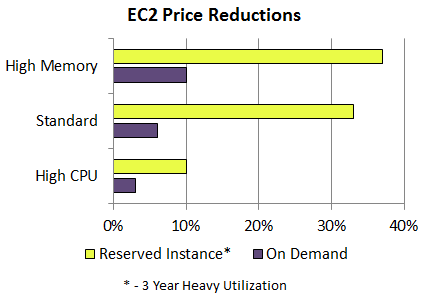
For a full list of our new prices, go to the Amazon EC2 pricing page.
We have a few flavors of Reserved Instances that allow you to optimize your cost for the usage profile of your application. If you run your instances steady state, Heavy Utilization Reserved Instances are the least expensive on a per hour basis. Other variants cost a little more per hour in exchange for the flexibility of being able to turn them off and save on the usage costs when you are not using them. This can save you money if you dont need to run your instance all of the time. For more details on which type of Reserved Instances are best for you, see the EC2 Reserved Instances page.
Save Even More on EC2 as You Get Bigger
One misperception we sometimes hear is that while EC2 is a phenomenal deal for smaller businesses, the cost benefit may diminish for large customers who achieve scale. We have lots of customers of all sizes, and those who take the time to rigorously run the numbers see significant cost advantages in using EC2 regardless of the size of their operations.
Today, were enabling customers to save even more as they scale — by introducing Reserved Instance volume tiers. In order to determine what tier you qualify for, you add up all of the upfront Reserved Instance payments for any Reserved Instances that you own. If you own more than $250,000 of Reserved Instances, you qualify for a 10% discount on any additional Reserved Instances you buy (that discount applies to both the upfront and the usage prices). If you own more than $2 Million of Reserved Instances, you qualify for a 20% discount on any new Reserved Instances you buy. Once you cross $5 Million in Reserved Instance purchases, give us a call and we will see what we can do to reduce prices for you even further we look forward to speaking with you!
Price Reductions for Amazon RDS, Amazon Elastic MapReduce and Amazon ElastiCache
These price reductions dont just apply to EC2 though, as Amazon Elastic MapReduce customers will also benefit from lower prices on the EC2 instances they use. In addition, we are also lowering prices for Amazon Relational Database Service (Amazon RDS). Prices for new RDS Reserved Instances will decrease by up to 42%, with On-Demand Instances for RDS and ElastiCache decreasing by up to 10%.
Heres a quick example of how these price reductions will help customers save money. If you are a game developer using a Quadruple Extra Large RDS MySQL 1-year Heavy Utilization Reserved Instance to power a new game, the new pricing will save you over $550 per month (or 39%) for each new database instance you run. If you run an e-commerce application on AWS using an Extra Large multi-AZ RDS MySQL instance for your always-on database you will save more than $445 per month (or 37%) by using a 3-year Heavy Utilization Reserved Database Instance. If you added a two node Extra Large ElastiCache cluster for better performance, you will save an additional $80 per month (or 10%). For a full list of the new prices, go to the Amazon RDS pricing page, Amazon ElastiCache pricing page, and the Amazon EMR pricing page.
Real Customer Savings
Lets put these cost savings into context. One of our fast growing customers was primarily running Amazon EC2 On-Demand instances, running 360,000 hours last month using a mix of M1.XL, M1.large, M2.2XL and M2.4XL instances. Without this customer changing a thing, with our new EC2 pricing, their bill will drop by over $25,000 next month, or $300,000 per year an 8.6% savings in their On-Demand spend. This customer was in the process of switching to 3-year Heavy Utilization Reserved Instances (seeing most of their instances are running steady state) for a whopping savings of 55%. Now, with the new EC2 price drop we’re announcing today, this customer will save another 37% on these Reserved Instances. Additionally, with the introduction of our new volume tiers, this customer will add another 10% discount on top of all that. In all, this price reduction, the new volume discount tiers, and the move to Reserved Instances will save the customer over $215,000 per month, or $2.6 million per year over what they are paying today, reducing their bill by 76%!
Many of our customers were already saving significant amounts of money before this price drop, simply by running on AWS. Samsung uses AWS to power its smart hub application which powers the apps you can use through their TVs and they recently shared with us that by using AWS they are saving $34 million in capital expenses over 2 years and reducing their operating expenses by 85%. According to their team, with AWS, they met reliability and performance objectives at a fraction of the cost they would have otherwise incurred.
Another customer example is foursquare Labs, Inc., They use AWS to perform analytics across more than 5 million daily check-ins. foursquare runs Amazon Elastic MapReduce clusters for their data analytics platform, using a mix of High Memory and High CPU instances. Previously, this EMR analytics cluster was running On-Demand EC2 Instances, but just recently, foursquare decided they would buy over $1 million of 1-year Heavy Utilization Reserved Instances, reducing their costs by 35% while still using some On-Demand instances to provide them with the flexibility to scale up or shed instances as needed. However, the new EC2 price drop lowers their costs even further. This price reduction will help foursquare save another 22%, and their overall EC2 Reserved Instance usage for their EMR cluster qualifies them for the additional 10% volume tier discount on top of that. This price drop combined with the move to Reserved Instances will help foursquare reduce their EC2 instance costs by over 53% from last month without sacrificing any of the scaling provided by EC2 and Elastic MapReduce.
As we continue to find ways to lower our own cost structure, we will continue to pass these savings back to our customers in the form of lower prices. Some companies work hard to lower their costs so they can pocket more margin. Thats a strategy that a lot of the traditional technology companies have employed for years, and its a reasonable business model. Its just not ours. We want customers of all sizes, from start-ups to enterprises to government agencies, to be able to use AWS to lower their technology infrastructure costs and focus their scarce engineering resources on work that actually differentiates their businesses and moves their missions forward. We hope this is another helpful step in that direction.
You can use the AWS Simple Monthly Calculator to see the savings first-hand.
— Jeff;
Launch Relational Database Service Instances in the Virtual Private Cloud
You can now launch Amazon Relational Database Service (RDS) DB instances inside of a Virtual Private Cloud (VPC).
Some Background
The Relational Database Service takes care of all of the messiness associated with running a relational database. You don’t have to worry about finding and configuring hardware, installing an operating system or a database engine, setting up backups, arranging for fault detection and failover, or scaling compute or storage as your needs change.

The Virtual Private Cloud lets you create a private, isolated section of the AWS Cloud. You have complete control over IP address ranges, subnetting, routing tables, and network gateways to your own data center and to the Internet.
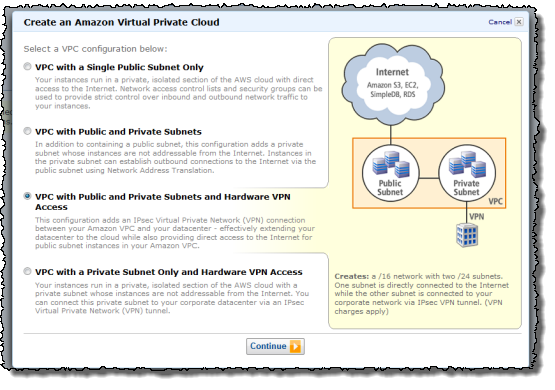
Here We Go
Before you launch an RDS DB Instance inside of a VPC, you must first create the VPC and partition its IP address range in to the desired subnets. You can do this using the VPC wizard pictured above, the VPC command line tools, or the VPC APIs.
Then you need to create a DB Subnet Group. The Subnet Group should have at least one subnet in each Availability Zone of the target Region; it identifies the subnets (and the corresponding IP address ranges) where you would like to be able to run DB Instances within the VPC. This will allow a Multi-AZ deployment of RDS to create a new standby in another Availability Zone should the need arise. You need to do this even for Single-AZ deployments, just in case you want to convert them to Multi-AZ at some point.
You can create a DB Security Group, or you can use the default. The DB Security Group gives you control over access to your DB Instances; you can allow access from EC2 instances with specific EC2 Security Group or VPC Security Groups membership, or from designated ranges of IP addresses. You can also use VPC subnets and the associated network Access Control Lists (ACLs) if you’d like. You have a lot of control and a lot of flexibility.
The next step is to launch a DB Instance within the VPC while referencing the DB Subnet Group and a DB Security Group. With this release, you are able to use the MySQL DB engine (we plan to additional options over time). The DB Instance will have an Elastic Network Interface using an IP address selected from your DB Subnet Group. You can use the IP address to reach the instance if you’d like, but we recommend that you use the instance’s DNS name instead since the IP address can change during failover of a Multi-AZ deployment.
Upgrading to VPC
If you are running an RDB DB Instance outside of a VPC, you can snapshot the DB Instance and then restore the snapshot into the DB Subnet Group of your choice. You cannot, however, access or use snapshots taken from within a VPC outside of the VPC. This is a restriction that we have put in to place for security reasons.
Use Cases and Access Options
You can put this new combination (RDS + VPC) to use in a variety of ways. Here are some suggestions:
- Private DB Instances Within a VPC – This is the most obvious and straightforward use case, and is a perfect way to run corporate applications that are not intended to be accessed from the Internet.
- Public facing Web Application with Private Database – Host the web site on a public-facing subnet and the DB Instances on a private subnet that has no Internet access. The application server and the RDB DB Instances will not have public IP addresses.
Your Turn
You can launch RDS instances in your VPCs today in all of the AWS Regions except AWS GovCloud (US). What are you waiting for?
— Jeff;
Additional Reserved Instance Options for Amazon RDS
Hot on the heels of our announcement of Additional Reserved Instance Options for Amazon EC2, I would like to tell you about a similar option for the Amazon Relational Database Service.
We have added Light and Heavy Utilization Reserved Instances for the MySQL and Oracle database engines. You can save 30% to 55% of your On-Demand DB Instance costs, depending on your usage.
Light Utilization Reserved Instances offer the lowers upfront payment, and ideal for DB instances that are used sporadically for development and testing, or for short-term projects. You can save up to 30% on a 1-year term and 35% on a 3-year term when compared to the same instance on an On-Demand basis.
Medium Utilization Reserved Instances have a higher upfront payment than Light Utilization Reserved Instances, but a much lower hourly usage fee. They are suitable for workloads that run most of the time, with some variability in usage. Savings range up to 35% for a 1-year term and 48% for a 3-year term when compared to On-Demand. These are the same Reserved Instances that we have offered since August 2010.
Heavy Utilization Reserved Instances are the best value for steady-state production database instances that are destinated to be running 24×7. With this type of Reserved Instance you pay an upfront fee and a low hourly rate for every hour of the one or three year term. You can save 41% for a 1-year term and 55% for a 3-year term.
These Reserved Instance offerings allow you to optimize your costs depending on your workload. The table below shows which Amazon RDS offerings you can use to lower your RDS costs. For example, if you need a DB instance for 5 months, a Light Utilization Reserved Instance will provide you the lowest effective cost.
| 1-Year Term | 3-Year Term | |
| On-Demand | 1-3 Months | 1-4 Months |
| Light Utilization | 4-8 Months | 5-12 Months |
| Medium Utilization | 9-10 Months | 13-29 Months |
| Heavy Utilization | 11-12 Months | 30-36 Months |
Learn more about this feature and other RDS pricing options on the Amazon RDS pricing page.
As always, we enjoy lowering our prices so that AWS becomes an even better value for you.
— Jeff;
AWS Summer Startups: Discovr
Over the summer months, we’d like to share a few stories from startups around the world: what are they working on and how they are using the cloud to get things done. Today, we’re profiling Filter Squad from Perth, Australia!
In one of Werner Vogels‘ many travels through Australia this summer, he tweeted about a lean startup he had met, Filter Squad. Lean startups, not to be confused with bootstrapped startups, are built by adapting agile software development methodologies to business. Some of the concepts include building a minimum viable product, testing business assumptions with real market data, measuring results, and then quickly iterating or pivoting depending on what that data shows you. The concept of a “lean startup” was coined by entrepreneur & author Eric Ries.
I reached out and spoke to Stuart Hall, CTO of Filter Squad, and creator of, among others, the Discovr Apps and Discovr Music for the iPhone & iPad.
- Low maintenance
- Easy to scale
- Simple to setup
- Provided good redundancy
- Amazon EC2 – because we had no idea of the market reaction to the application when we launched, flexibility in adding and removing virtual servers based on demand was key.
- Amazon RDS – we needed a database that would also be easy to scale and be easy to maintain. Amazon RDS provided easy scaling, easy replication for slave instances, and a system where minor software updates are handled entirely by AWS.
- Amazon S3 – S3 provides a great and cheap way to host static resources, one with which we had worked before and found ideal for our use case.
- Amazon Elastic Load Balancer – the load balancer is provided straight out of the box: it doesn’t require any installing and it needs very little configuration. The load balancer provides built in health checks and takes out instances that are not behaving. Elastic load balancing has been faultless since we launched.
- Caching: the only thing missing was a caching solution, which AWS has since launched and we will be soon moving to. This was also a big consideration, the pace at which AWS are iterating and improving their service matches our philosophy to application development.
- Build a great product, then don’t forget to market it!
- Treat your customers like precious gold.
- Make it easy for your customers to talk to you and listen to what they say.
- Cross-promote your app with other apps that youve also built.
We’ve collected some lessons learned on our blog: how we got 250k downloads in 4 days.
——————————————————
8 Days Left to Enter Your Startup in the AWS Start-up Challenge!
This year’s AWS Start-up Challenge is a worldwide competition with prizes at all levels, including up to $100,000 in cash, AWS credits, and more for the grand prize winner. Learn more and enter today!
You can also follow @AWSStartups on Twitter for startup-related updates.
-rodica
Facebook Developer Update: Meet RootMusic, Funzio, and 50Cubes
In honor of today’s Facebook Developer Conference, I’d like to recognize the success of our existing Facebook app developers and invite even more developers to kick-start their next Facebook app project with Amazon Web Services.
Quick Numbers
We crunched some numbers and found out that 70% of the 50 most popular Facebook apps leverage one or more AWS services. Many of their developers rely on AWS to provide them with compute, network, storage, database and messaging services on a pay-as-you-go basis. In addition to Zyngas popular FarmVille and CafeWorld, or games from Playfish and Wooga, many of the most exciting and popular Facebook apps are also running on AWS.
Here are a few examples:
 RootMusic‘s BandPage app (currently the #1 Music App on Facebook, and #8 overall app on Facebook) helps bands and musicians build fan pages that will attract and hold the interest of an audience. RootMusic enables artists to tap into the passion their fans feel for their art and keep them engaged with an interactive experience. More than 250,000 bands of all shapes and sizes, from Rihanna and Arctic Monkeys, to bands you haven’t heard of yet but may soon discover, have already made RootMusics BandPage their central online space for connecting with their fans. Artists use it to share music, release special edition songs/albums here, share photos, and list events/shows. BandPage now supports 30 million monthly active users from all over the world. Behind all the capabilities that ignite BandPages music fan communities lies a well-thought out, highly-distributed and highly-scalable backend, powered by Amazon Web Services:
RootMusic‘s BandPage app (currently the #1 Music App on Facebook, and #8 overall app on Facebook) helps bands and musicians build fan pages that will attract and hold the interest of an audience. RootMusic enables artists to tap into the passion their fans feel for their art and keep them engaged with an interactive experience. More than 250,000 bands of all shapes and sizes, from Rihanna and Arctic Monkeys, to bands you haven’t heard of yet but may soon discover, have already made RootMusics BandPage their central online space for connecting with their fans. Artists use it to share music, release special edition songs/albums here, share photos, and list events/shows. BandPage now supports 30 million monthly active users from all over the world. Behind all the capabilities that ignite BandPages music fan communities lies a well-thought out, highly-distributed and highly-scalable backend, powered by Amazon Web Services:
“In 20 seconds, we can double our server capacity. In a high-growth environment like ours, it’s very important for us to trust that we have the best support to give to the music community around the world. Five years ago, we would have crashed and been down without knowing when we would be back. Now, because of Amazons continued innovation, we can provide the best technology and scale to serve music communities needs around the world, Christopher Tholen, RootMusic CTO.
 Funzio‘s Crime City is #7 in the top 10 Facebook apps, and its the highest rated Facebook game to reach 1 million daily users with an average user rating of 4.9 out of 5. Crime City currently has 5.5 million monthly active users, with 10 million monthly active users at its peak. The iPhone version was recently listed among the top 5 games in the Apple Appstore and #1 free game in 11 countries and counting. Crime City sports modern, 3D-like graphics that look great on both Facebook and iPhone, and has a collection of hundreds of virtual items that players can collect.
Funzio‘s Crime City is #7 in the top 10 Facebook apps, and its the highest rated Facebook game to reach 1 million daily users with an average user rating of 4.9 out of 5. Crime City currently has 5.5 million monthly active users, with 10 million monthly active users at its peak. The iPhone version was recently listed among the top 5 games in the Apple Appstore and #1 free game in 11 countries and counting. Crime City sports modern, 3D-like graphics that look great on both Facebook and iPhone, and has a collection of hundreds of virtual items that players can collect.
Powering this incredibly rich user experience across multiple platforms is their business acumen in promoting the app, as well as a strong backend that leverages many AWS products to serve their viral and highly active user base. Funzio uses Amazon EC2 to quickly scale up and down based on demand, Amazon RDS to store game and current state information. They use Amazon CloudFront to optimize the delivery to a global, widely-distributed audience and to meet Facebook’s SSL certificate requirements.
“At Funzio, we use AWS exclusively to host the infrastructure for our games. When developing social games, you need to be ready for that traffic burst for a hit game in a moment’s notice. AWS provides us with the flexibility to quickly and efficiently scale our applications at all layers, from increasing database capacity in RDS, to adding more application or caching servers within minutes in EC2. Amazon’s cloud services allow us to focus our efforts on developing quality games and not on worrying about managing our technology operations. – Ram Gudavalli, Funzio CTO.
 50Cubes, the creator of Mall World, is a startup that has developed one of the most highly-regarded and longer-running successful female focused social game on Facebook. With over 5 million monthly active users, Mall World has a track record of being not only one of the first but also the top game of its kind for the past 1.5 years and continues to entice users world-wide.
50Cubes, the creator of Mall World, is a startup that has developed one of the most highly-regarded and longer-running successful female focused social game on Facebook. With over 5 million monthly active users, Mall World has a track record of being not only one of the first but also the top game of its kind for the past 1.5 years and continues to entice users world-wide.
50Cubes powers Mall World and other games they developed with a suite of AWS products. Out of these, they value the Amazon Auto-scaling and EBS features the most these products helps them effortlessly scale up and down their exclusive use of Amazon EC2 instances with user demand. Their database clusters are a mix of MySQL and other key value storage databases, all hosted and managed by the team on Amazon EC2 using EBS for Cloud Storage.
“One thing that impresses me the most about AWS services is that they have rapidly iterated and improved their products and services over the past year and half, executing almost like a startup of our scale.” – Fred Jin, 50cubes CTO.
Get Started: Your Facebook App, Powered by AWS
Doug Purdy, Director of Developer Relations at Facebook, said:
AWS is great for Facebook developers you can start small, test and prove your ideas. As your app grows, you can easily scale up your resources to keep your users engaged and connected. AWS allows developers to build highly-available, highly-scalable, cost-efficient apps that provide the type of rich and responsive user experiences that our global audience has grown to expect.
To make it as easy as possible for you to get started, we’ve updated our Building Facebook Apps on AWS page. We have also improved and refreshed our Facebook App AMI. The new AMI uses AWS CloudFormation to install the latest versions of the Facebook PHP SDK and the AWS SDK for PHP at startup time. If you want to learn more about developing AWS applications in PHP, feel free to check out the free chapters of my AWS programming book (or buy a complete copy).
— Jeff;
Amazon RDS Updates – Oracle Improvements and a New Minor Version
We’ve made two important updates to Amazon RDS for Oracle Database:
- A new minor version (containing some critical security fixes) is now available.
- Additional access privileges are now available (via the new minor version) to applications.
New Minor Version
Oracle Database version 11.2.0.2.v3 is now available. Oracle recommends an immediate upgrade to this version due to the critical security fixes that it contains.
Due to the critical nature of the fixes contained in this release we plan to perform an automatic minor version upgrade to all applicable RDS DB Instances in the near future (refer to the RDS Forum announcement for the exact timing). You can also upgrade now by opening the RDS page of the AWS Management Console, choosing the Modify DB Instance option, and selecting the new DB Engine Version:
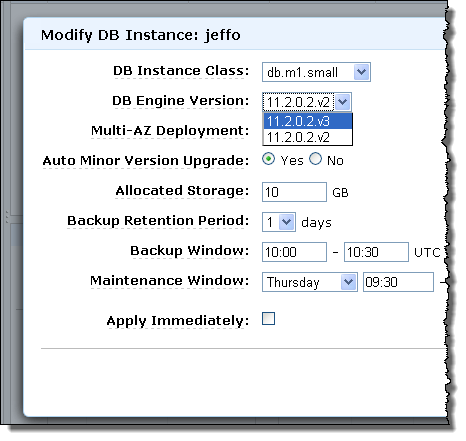
Select Apply Immediately to make the change right away, or leave it unchecked to defer the update until the next maintenance window for your DB Instance.
Additional Access Privileges
Our customers have been asking for additional access privileges and we are happy to announce that the following privileges are now available in the new minor version (11.2.0.2.v3):
- Execute privileges to a number of DBMS packages including DBMS_CRYPTO, DBMS_ALERT, DBMS_LOCK, and DBMS_PIPE are now available, as are privileges to grant DBA, CONNECT, and RESOURCES roles to other users.
- The CTXAPP role is now available, and can also be granted to other users.
- The system privileges RESTRICTED SESSION and GRANT ANY OBJECT PRIVILEGE are now available.
— Jeff;
AWS Summer Startups: ShowNearby
ShowNearby is a leading location-based service in Singapore and an early adopter of the Android platform. Unlike many mobile apps out there, ShowNearby started with deployment on Android and then moved on to the iPhone by mid 2010 and Blackberry by fall of 2010. Today, the ShowNearby flagship app is available on Android, iPhone and Blackberry and reports approximately 100 Million mobile searches conducted across all its platforms.
Due to the success of our application, we had a very big growth in a short period of time. When we launched on the popular platforms of iOS and subsequently BlackBerry, we were blown away by the huge surge of users that started using ShowNearby. In fact in December of 2010, ShowNearby became the top downloaded app in the App store, edging out thousands of other popular free apps in Singapore! It was then that we realized we needed a scalable solution to handle the increasing load and strain on our servers that our existing provider was unable to provide.
Our infrastructure at the time was hosted with a local service provider, but was unable to cope with the high traffic peaks we were facing.We analyzed a few vendors and decided to go ahead with Amazon because of it’s reliability, high availability, range of services and pricing, but mostly because of its solid customer support.
As part of our deployment, we added AWS services incrementally. Currently we use extensively Amazon EC2 instances with auto scaling, Relational Database Service (RDS), Simple Queue Service (SQS), Cloudwatch and Simple Storage Service (S3).
Next item on our list is to focus on automating the deployment of infrastructure environments with cloud formations, as well as optimizing content delivery globally with Cloudfront.
Choosing the Tech Stack That Makes Business Sense
ShowNearby currently leverages on the LAMP stack for most our web services. Delivery of accurate, always available, location based data is ShowNearbys top priority.That is why we chose AWS.
Other important things why to choose cloud/AWS: Speed and agility to create and tear down infrastructure as and when it is needed. Good and fast network accessibility for our app. Ability to scale up and out when needed. Ability to duplicate infrastructure into new regions.
Reaching Automation Nirvana with AWS
We chose to use AWSs Linux based AMI and dynamically build on top of it using well defined, automatic configuration. Now, every time an instance is started, we are sure the infrastructure is always in a known state. Admittedly, a lot of hard work is involved to achieve Automation Nirvana, but knowing precisely what works at the end of the day helps us sleep at night.
- We use Amazon S3 to store infrastructure configuration and user provided content/images. ShowNearbys business is currently in, and marching into new, regions, so S3 is a natural precursor to AWSs CloudFront content distribution service.
- We use SQS to help process user behaviour and to determine usage patterns.
- We use this to provide our dear users with a better, and hopefully, more personalised experience.We use spot instances for early development & testing servers.
- We use CloudWatch extensively – how could we do without it?
- We use RDS, for our hosted mySQL databased needs, of course
- We use the command-line and PHP AWS API tools to a large extent, which provides us increased business agility.
Words of Wisdom for Mobile Startups
We would tell them to find partners who can be good friends at the same time. The race is long and tough, so better do it enjoying every step of the way. There is a window of opportunity in Asia now open to unleash your full potential, show what you are capable of and you’ll be rewarded.
Today, if we need to refresh or update a web application, we restart new instances and flush out the old. Moving forward, we are looking into reducing the time between releases still further and so, we are working to improve on our already solid infrastructure and configuration management. Further automation in the form of Chef and/or Puppet or similar is being investigated.
——————————————————
Enter Your Startup in the AWS Start-up Challenge!
This year’s AWS Start-up Challenge is a worldwide competition with prizes at all levels, including up to $100,000 in cash, AWS credits, and more for the grand prize winner. 7 Finalists receive $10,000 in AWS credits and 5 regional semi-finalists receive $2,500 in AWS credits. All eligible entries receive $25 in AWS credits. Learn more and enter today!
You can also follow @AWSStartups on Twitter for updates.
-rodica
AWS Summer Startups: Classle
Over the summer months, we’d like to share a few stories from startups around the world: what are they working on and how they are using the cloud to get things done. Today, we’re profiling Classle, from Chennai, India!
I recently read Mark Susters blog on Avoiding Monoculture – which is why Im happy to share with you what Ive learned about Classle, a startup from India, focused on solving education problems for areas of the world that experience serious resource constraints. Classle has the big goal of changing the world around them by encouraging students and experts to share knowledge and expertise, and using the AWS cloud to facilitate this exchange.
I reached out to Vaidya Nathan, Founder and CEO of Classle:
Classle is a Social Learning infrastructure company with specific focus on Education, Learning and Knowledge communities. Using the main Classle product, Cloud Campus platform, Classle creates and manages private and public social learning environments and offers services based on it.
We are using AWS since our inception in early 2009. Our first steps involved two small Amazon EC2 instances and Amazon EBS to store our database. Over the years, our use has expanded to match our business growth. Our selection criteria covered tactical as well as strategic points. From a tactical perspective, we wanted a quicker time for provisioning, which AWS on-demand instances enabled, and the option to secure our resource needs through Reserved Instances.
At a strategic level, we wanted to provide the best experience for our customers and it was key to build Classle on top of services, products, and infrastructure designed for growth and scale. To date, we have established relationships with over 30 educational organizations and that list is constantly growing. Thanks to AWS, we are effectively competing with some large and strong players in the e-learning space.
Sharing the AWS Lessons:
We are a small, LAMP stack team and we started using AWS in 2009. Currently, the products we are using are below. For reference, we are also happy to share our Classle architecture diagram, which is included in our case study with AWS.
- Amazon Elastic Compute Cloud (EC2)
- Elastic Load Balancing (ELB)
- AutoscalingAmazon Elastic Bock Storage (EBS)
- Amazon Simple Storage Service (S3)
- Amazon Reduced Redundancy Storage (RRS)
- Amazon CloudFront with both streaming and download
- Amazon Cloud Watch
- Amazon Relational Database Service (Amazon RDS) with Multi-AZ and Read replication.
- Amazon SimpleDB
- Amazon Simple Notification Service (Amazon SNS)
- Amazon Route 53
Pretty soon, we would be using Amazon Elastic Map-Reduce clusters for our analytics requirements..
Words of Wisdom to Startups
Starting a company is always hard, whether youre from India or anywhere else. However, its worth to keep in mind that its never been easier to go out there and try things out – with Open Source for robust software and cloud service providers like AWS for infrastructure, you can test your ideas and run a business at very low cost.
Being from in India, where we dont have a strong start-up mentality like in the U.S., certainly poses some unique challenges. There are many more problems to solve, and it is exciting to try and translate the existing limitations into innovations, solutions and hence opportunities.
If I had to boil down my advice, I would say to my fellow entrepreneurs to: venture with confidence, design for scale, start small & architect for growth.
——————————————————
Enter Your Startup in the AWS Start-up Challenge!
This year’s AWS Start-up Challenge is a worldwide competition with prizes at all levels, including up to $100,000 in cash, AWS credits, and more for the grand prize winner. Learn more and enter today!
You can also follow @AWSStartups on Twitter for updates.
-rodica



